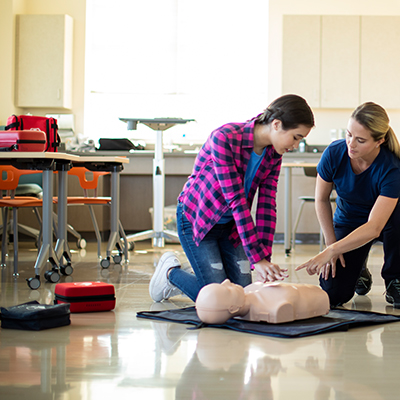Automated External Defibrillators (AEDs) are making their way into public facilities of all types. They can be found in schools, college campuses, and athletic centers, as well as office buildings, malls, and airports.
AEDs are important life-saving devices, but if you don’t know how to use them (or don’t feel comfortable following the machine’s guided prompts), you could be putting yourself and others at risk. Luckily there is something you can do about that – take advantage of some first aid courses that specialize in AED training classes and become AED certified.
Understanding How AEDs Work
AEDs save lives by helping people who suffer sudden cardiac arrest (SCA). SCA is a medical emergency during which the heart stops beating normally and doesn’t pump blood to the rest of the body. (AEDs are different from manual defibrillators used by healthcare providers.)
The majority of SCA instances are caused by ventricular fibrillation, a condition in which the lower chambers of the heart (or ventricles) do not pump correctly, causing an irregular heartbeat known as an arrhythmia.
When an AED is attached to a SCA victim, the electrodes placed on the person’s chest send information to the AED’s built-in computer. The AED determines if an electrical shock is needed to temporarily stun the heart and allow a normal rhythm to restart. For every minute that a victim’s heart is not defibrillated, that person’s chances of survival drop by seven to ten percent.
The Importance of Being AED Certified
The importance of being AED certified cannot be overstated. Your certification shows that you have taken the time to study, learn and practice using an AED, and often, training includes a CPR certification course, as well.
CPR AED certification also helps to provide a sense of confidence in yourself as a rescuer. You can use your knowledge and skills to help save lives in emergency situations when someone needs cardiopulmonary resuscitation (CPR) or defibrillation to stay alive until medical care arrives.
Who Should Complete an AED Certification Program?
Anybody can take AED training courses to become AED certified. However, certain jobs require bloodborne pathogen, first aid certification, basic life support (BLS), and CPR classes. So, if you have to take any of those basic first aid training programs, it makes sense to also take AED training classes, as well. These individuals should strongly consider taking AED courses:
- Teachers and school staff.
- Coaches, sport trainers, and lifeguards.
- Those with jobs around heavy machinery, water, or power lines.
OSHA may require safety training for certain jobs and industries. Medical professionals and first responders, for example, complete a variety of certifications and trainings. Be sure to take a look at their website to learn more about the OSHA Training Institute and Education Centers.
How Do You Become AED Certified?
There are a few ways to become AED certified. The American Heart Association (AHA) offers training and certification programs, and you don’t have to be an official member of the AHA to take their courses. You can also look into programs offered by other organizations, such as the American Safety & Health Institute (ASHI), the National Safety Council (NSC), or the American Red Cross. All of these organizations offer AED certification classes (both online courses and in person classes).
AED course material is generally taught by emergency responders and medical professionals. As with CPR certification, once you complete your training you’ll be issued a certification card as well as a digital certificate. Typically, recertification is required after two years.
What Are the Benefits of Being AED Certified?
Becoming AED certified allows you to help people in your community. When there’s an emergency situation, you’ll be able to recognize the signs of a heart attack and be able to act accordingly using the hands-on skills you’ve learned.
AED certification helps non-healthcare professionals act immediately (and not freeze) in an emergency (which is especially true when dealing with an infant or pediatric victim). With proper training, you can allow the training to “take over” and follow the steps as you learned them.
The Chain of Survival
Defibrillation is an important link in the so-called “chain of survival.” The first link is to call emergency services. The next is to begin proper CPR (ie. adult CPR versus infant CPR). The third link is the one that we’re concentrating on today, and that’s defibrillation, which keeps the victim alive until emergency services arrive.
Just as CPR training helps someone do CPR correctly, AED training helps to ensure that no time is wasted when delivering defibrillation.
AED Training Saves Lives
AED training gives you comfort knowing that when a cardiac emergency happens you’ll know how to react and can utilize an AED. If your school or organization needs a training AED unit or a fully functioning AED, contact Penn Care. We have the best selection of medical equipment, PPE, and emergency vehicles available on the market!



